2007 CHEVROLET CORVETTE ECO mode
[x] Cancel search: ECO modePage 3 of 488

GENERAL MOTORS, GM, the GM Emblem,
CHEVROLET, the CHEVROLET Emblem,
the names CORVETTE and Z06 and the
CORVETTE Emblem are registered trademarks
of General Motors Corporation.
This manual includes the latest information at the
time it was printed. We reserve the right to
make changes after that time without further
notice. For vehicles �rst sold in Canada, substitute
the name “General Motors of Canada Limited”
for Chevrolet Motor Division whenever it appears
in this manual.This manual describes features that may be
available in this model, but your vehicle may not
have all of them. For example, more than one
entertainment system may be offered or your
vehicle may have been ordered without a front
passenger or rear seats.
Keep this manual the vehicle, so it will be there if
it is needed when on the road. If the vehicle is
sold, leave this manual in it.
Canadian Owners
A French language copy of this manual can be
obtained from your dealer/retailer or from:
Helm, Incorporated
P.O. Box 07130
Detroit, MI 48207
Litho in U.S.A.
Part No. 15865975 B Second Printing
©2006 General Motors Corporation. All Rights Reserved.
3
Page 48 of 488
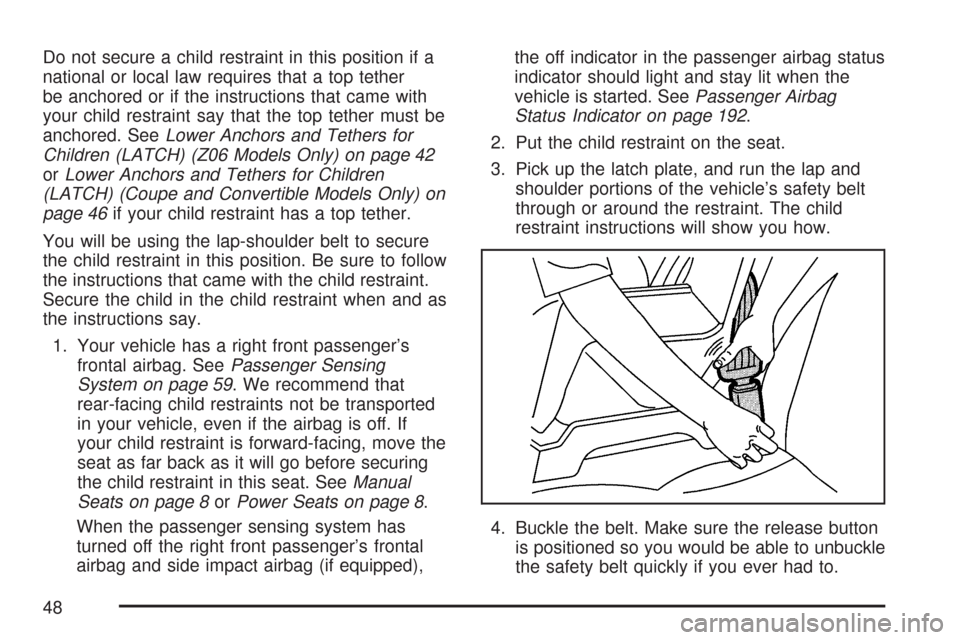
Do not secure a child restraint in this position if a
national or local law requires that a top tether
be anchored or if the instructions that came with
your child restraint say that the top tether must be
anchored. SeeLower Anchors and Tethers for
Children (LATCH) (Z06 Models Only) on page 42
orLower Anchors and Tethers for Children
(LATCH) (Coupe and Convertible Models Only) on
page 46if your child restraint has a top tether.
You will be using the lap-shoulder belt to secure
the child restraint in this position. Be sure to follow
the instructions that came with the child restraint.
Secure the child in the child restraint when and as
the instructions say.
1. Your vehicle has a right front passenger’s
frontal airbag. SeePassenger Sensing
System on page 59. We recommend that
rear-facing child restraints not be transported
in your vehicle, even if the airbag is off. If
your child restraint is forward-facing, move the
seat as far back as it will go before securing
the child restraint in this seat. SeeManual
Seats on page 8orPower Seats on page 8.
When the passenger sensing system has
turned off the right front passenger’s frontal
airbag and side impact airbag (if equipped),the off indicator in the passenger airbag status
indicator should light and stay lit when the
vehicle is started. SeePassenger Airbag
Status Indicator on page 192.
2. Put the child restraint on the seat.
3. Pick up the latch plate, and run the lap and
shoulder portions of the vehicle’s safety belt
through or around the restraint. The child
restraint instructions will show you how.
4. Buckle the belt. Make sure the release button
is positioned so you would be able to unbuckle
the safety belt quickly if you ever had to.
48
Page 50 of 488
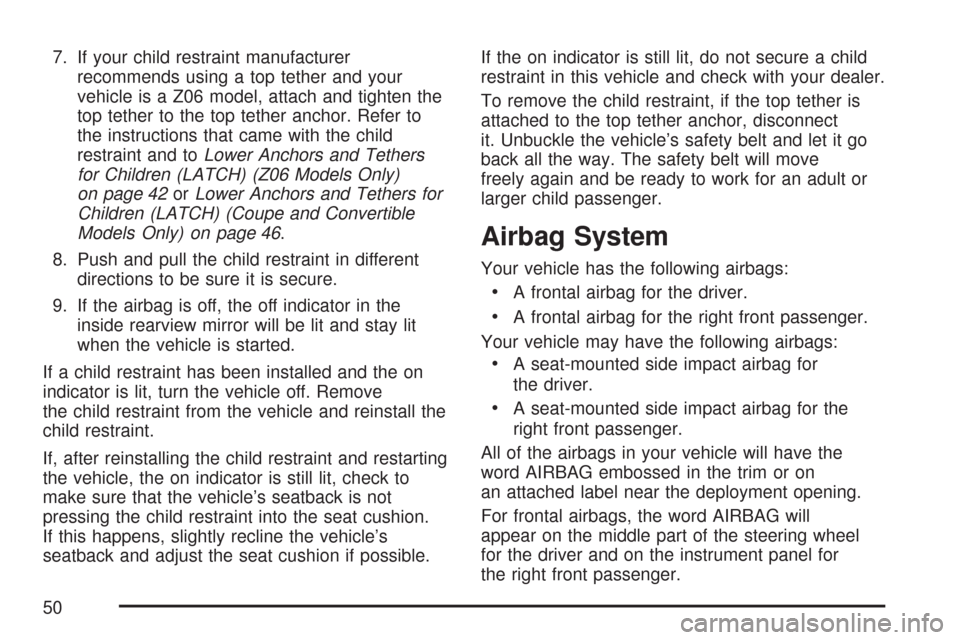
7. If your child restraint manufacturer
recommends using a top tether and your
vehicle is a Z06 model, attach and tighten the
top tether to the top tether anchor. Refer to
the instructions that came with the child
restraint and toLower Anchors and Tethers
for Children (LATCH) (Z06 Models Only)
on page 42orLower Anchors and Tethers for
Children (LATCH) (Coupe and Convertible
Models Only) on page 46.
8. Push and pull the child restraint in different
directions to be sure it is secure.
9. If the airbag is off, the off indicator in the
inside rearview mirror will be lit and stay lit
when the vehicle is started.
If a child restraint has been installed and the on
indicator is lit, turn the vehicle off. Remove
the child restraint from the vehicle and reinstall the
child restraint.
If, after reinstalling the child restraint and restarting
the vehicle, the on indicator is still lit, check to
make sure that the vehicle’s seatback is not
pressing the child restraint into the seat cushion.
If this happens, slightly recline the vehicle’s
seatback and adjust the seat cushion if possible.If the on indicator is still lit, do not secure a child
restraint in this vehicle and check with your dealer.
To remove the child restraint, if the top tether is
attached to the top tether anchor, disconnect
it. Unbuckle the vehicle’s safety belt and let it go
back all the way. The safety belt will move
freely again and be ready to work for an adult or
larger child passenger.
Airbag System
Your vehicle has the following airbags:
A frontal airbag for the driver.
A frontal airbag for the right front passenger.
Your vehicle may have the following airbags:
A seat-mounted side impact airbag for
the driver.
A seat-mounted side impact airbag for the
right front passenger.
All of the airbags in your vehicle will have the
word AIRBAG embossed in the trim or on
an attached label near the deployment opening.
For frontal airbags, the word AIRBAG will
appear on the middle part of the steering wheel
for the driver and on the instrument panel for
the right front passenger.
50
Page 76 of 488
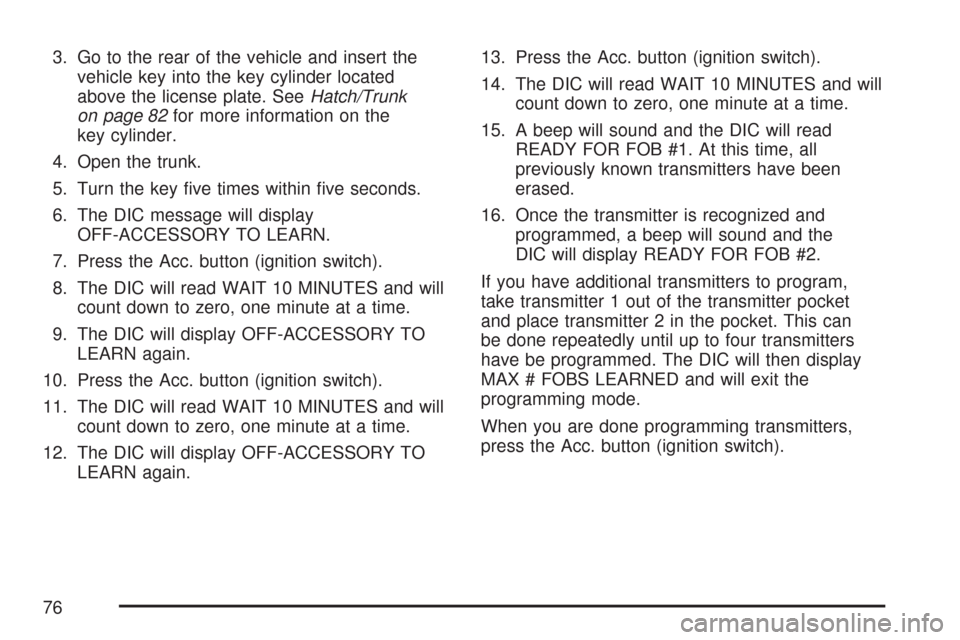
3. Go to the rear of the vehicle and insert the
vehicle key into the key cylinder located
above the license plate. SeeHatch/Trunk
on page 82for more information on the
key cylinder.
4. Open the trunk.
5. Turn the key �ve times within �ve seconds.
6. The DIC message will display
OFF-ACCESSORY TO LEARN.
7. Press the Acc. button (ignition switch).
8. The DIC will read WAIT 10 MINUTES and will
count down to zero, one minute at a time.
9. The DIC will display OFF-ACCESSORY TO
LEARN again.
10. Press the Acc. button (ignition switch).
11. The DIC will read WAIT 10 MINUTES and will
count down to zero, one minute at a time.
12. The DIC will display OFF-ACCESSORY TO
LEARN again.13. Press the Acc. button (ignition switch).
14. The DIC will read WAIT 10 MINUTES and will
count down to zero, one minute at a time.
15. A beep will sound and the DIC will read
READY FOR FOB #1. At this time, all
previously known transmitters have been
erased.
16. Once the transmitter is recognized and
programmed, a beep will sound and the
DIC will display READY FOR FOB #2.
If you have additional transmitters to program,
take transmitter 1 out of the transmitter pocket
and place transmitter 2 in the pocket. This can
be done repeatedly until up to four transmitters
have be programmed. The DIC will then display
MAX # FOBS LEARNED and will exit the
programming mode.
When you are done programming transmitters,
press the Acc. button (ignition switch).
76
Page 90 of 488
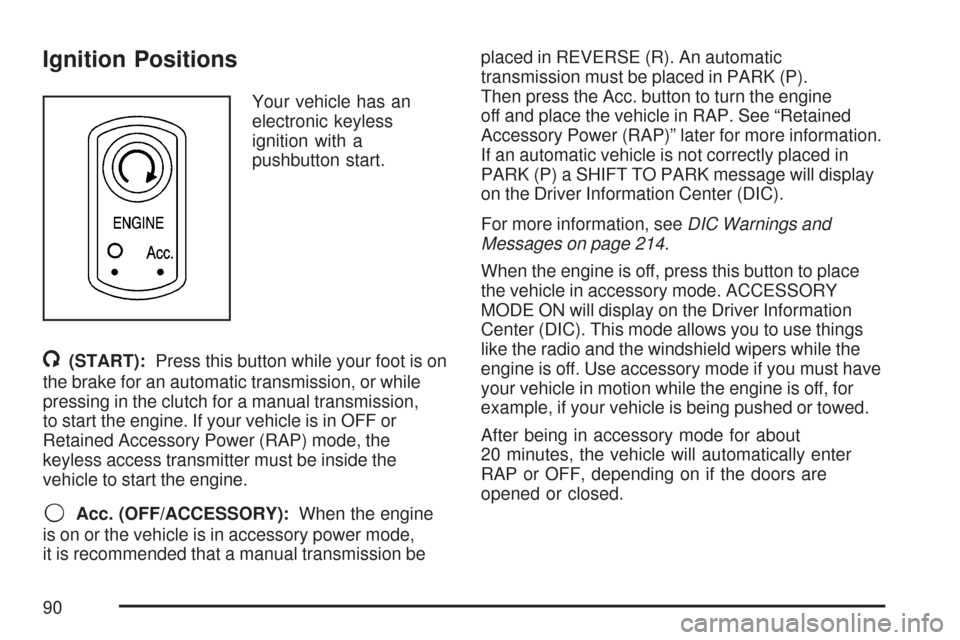
Ignition Positions
Your vehicle has an
electronic keyless
ignition with a
pushbutton start.
/(START):Press this button while your foot is on
the brake for an automatic transmission, or while
pressing in the clutch for a manual transmission,
to start the engine. If your vehicle is in OFF or
Retained Accessory Power (RAP) mode, the
keyless access transmitter must be inside the
vehicle to start the engine.
9Acc. (OFF/ACCESSORY):When the engine
is on or the vehicle is in accessory power mode,
it is recommended that a manual transmission beplaced in REVERSE (R). An automatic
transmission must be placed in PARK (P).
Then press the Acc. button to turn the engine
off and place the vehicle in RAP. See “Retained
Accessory Power (RAP)” later for more information.
If an automatic vehicle is not correctly placed in
PARK (P) a SHIFT TO PARK message will display
on the Driver Information Center (DIC).
For more information, seeDIC Warnings and
Messages on page 214.
When the engine is off, press this button to place
the vehicle in accessory mode. ACCESSORY
MODE ON will display on the Driver Information
Center (DIC). This mode allows you to use things
like the radio and the windshield wipers while the
engine is off. Use accessory mode if you must have
your vehicle in motion while the engine is off, for
example, if your vehicle is being pushed or towed.
After being in accessory mode for about
20 minutes, the vehicle will automatically enter
RAP or OFF, depending on if the doors are
opened or closed.
90
Page 93 of 488
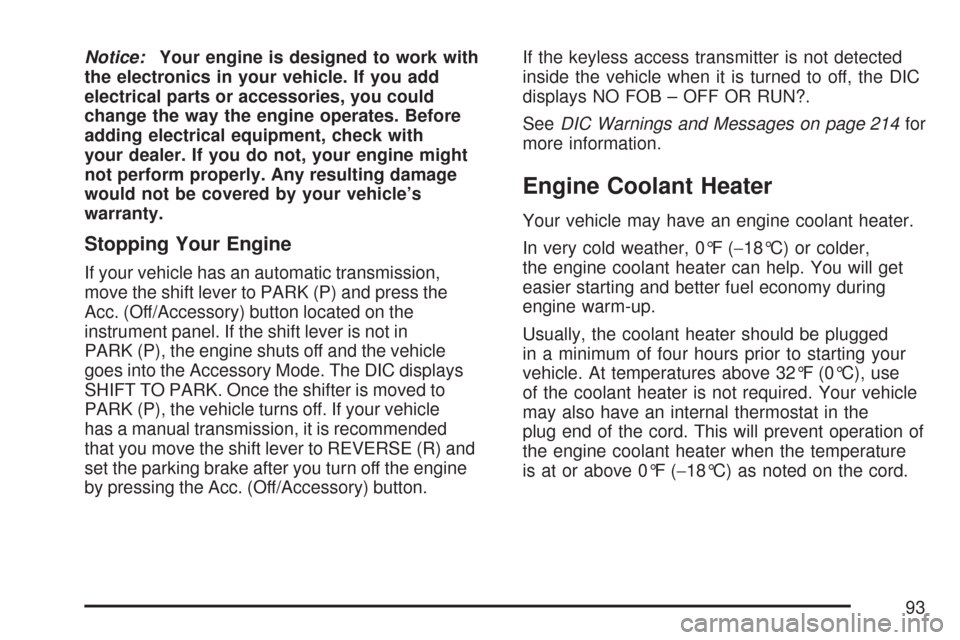
Notice:Your engine is designed to work with
the electronics in your vehicle. If you add
electrical parts or accessories, you could
change the way the engine operates. Before
adding electrical equipment, check with
your dealer. If you do not, your engine might
not perform properly. Any resulting damage
would not be covered by your vehicle’s
warranty.
Stopping Your Engine
If your vehicle has an automatic transmission,
move the shift lever to PARK (P) and press the
Acc. (Off/Accessory) button located on the
instrument panel. If the shift lever is not in
PARK (P), the engine shuts off and the vehicle
goes into the Accessory Mode. The DIC displays
SHIFT TO PARK. Once the shifter is moved to
PARK (P), the vehicle turns off. If your vehicle
has a manual transmission, it is recommended
that you move the shift lever to REVERSE (R) and
set the parking brake after you turn off the engine
by pressing the Acc. (Off/Accessory) button.If the keyless access transmitter is not detected
inside the vehicle when it is turned to off, the DIC
displays NO FOB – OFF OR RUN?.
SeeDIC Warnings and Messages on page 214for
more information.
Engine Coolant Heater
Your vehicle may have an engine coolant heater.
In very cold weather, 0°F (−18°C) or colder,
the engine coolant heater can help. You will get
easier starting and better fuel economy during
engine warm-up.
Usually, the coolant heater should be plugged
in a minimum of four hours prior to starting your
vehicle. At temperatures above 32°F (0°C), use
of the coolant heater is not required. Your vehicle
may also have an internal thermostat in the
plug end of the cord. This will prevent operation of
the engine coolant heater when the temperature
is at or above 0°F (−18°C) as noted on the cord.
93
Page 97 of 488
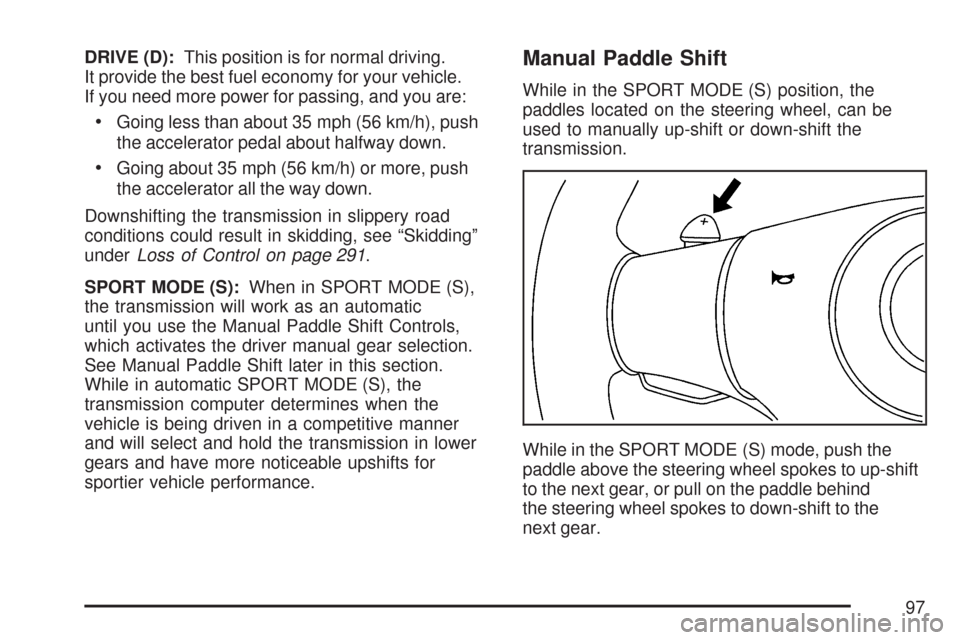
DRIVE (D):This position is for normal driving.
It provide the best fuel economy for your vehicle.
If you need more power for passing, and you are:
Going less than about 35 mph (56 km/h), push
the accelerator pedal about halfway down.
Going about 35 mph (56 km/h) or more, push
the accelerator all the way down.
Downshifting the transmission in slippery road
conditions could result in skidding, see “Skidding”
underLoss of Control on page 291.
SPORT MODE (S):When in SPORT MODE (S),
the transmission will work as an automatic
until you use the Manual Paddle Shift Controls,
which activates the driver manual gear selection.
See Manual Paddle Shift later in this section.
While in automatic SPORT MODE (S), the
transmission computer determines when the
vehicle is being driven in a competitive manner
and will select and hold the transmission in lower
gears and have more noticeable upshifts for
sportier vehicle performance.
Manual Paddle Shift
While in the SPORT MODE (S) position, the
paddles located on the steering wheel, can be
used to manually up-shift or down-shift the
transmission.
While in the SPORT MODE (S) mode, push the
paddle above the steering wheel spokes to up-shift
to the next gear, or pull on the paddle behind
the steering wheel spokes to down-shift to the
next gear.
97
Page 98 of 488
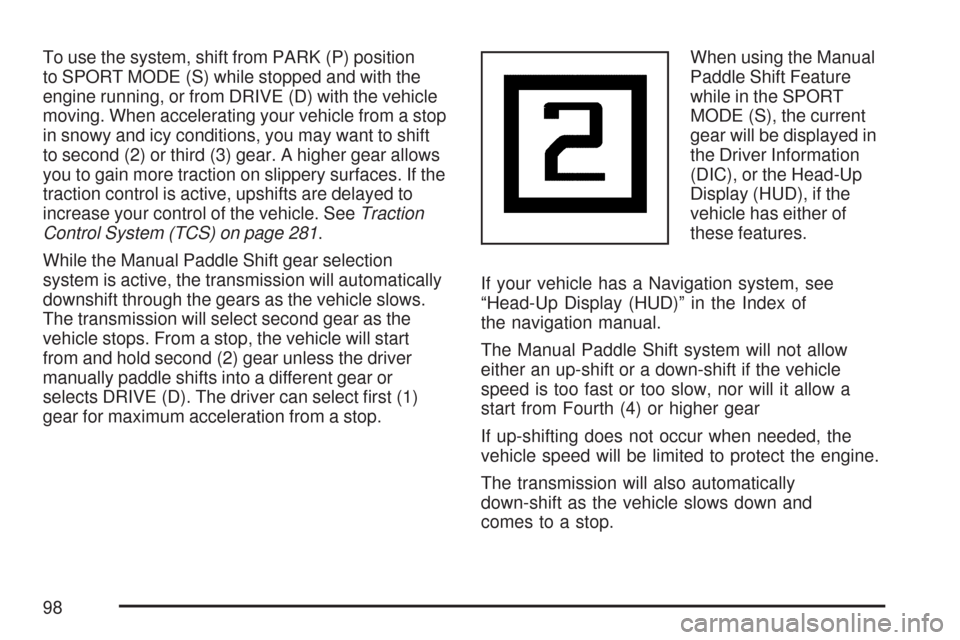
To use the system, shift from PARK (P) position
to SPORT MODE (S) while stopped and with the
engine running, or from DRIVE (D) with the vehicle
moving. When accelerating your vehicle from a stop
in snowy and icy conditions, you may want to shift
to second (2) or third (3) gear. A higher gear allows
you to gain more traction on slippery surfaces. If the
traction control is active, upshifts are delayed to
increase your control of the vehicle. SeeTraction
Control System (TCS) on page 281.
While the Manual Paddle Shift gear selection
system is active, the transmission will automatically
downshift through the gears as the vehicle slows.
The transmission will select second gear as the
vehicle stops. From a stop, the vehicle will start
from and hold second (2) gear unless the driver
manually paddle shifts into a different gear or
selects DRIVE (D). The driver can select �rst (1)
gear for maximum acceleration from a stop.When using the Manual
Paddle Shift Feature
while in the SPORT
MODE (S), the current
gear will be displayed in
the Driver Information
(DIC), or the Head-Up
Display (HUD), if the
vehicle has either of
these features.
If your vehicle has a Navigation system, see
“Head-Up Display (HUD)” in the Index of
the navigation manual.
The Manual Paddle Shift system will not allow
either an up-shift or a down-shift if the vehicle
speed is too fast or too slow, nor will it allow a
start from Fourth (4) or higher gear
If up-shifting does not occur when needed, the
vehicle speed will be limited to protect the engine.
The transmission will also automatically
down-shift as the vehicle slows down and
comes to a stop.
98